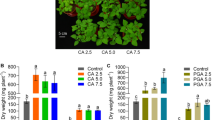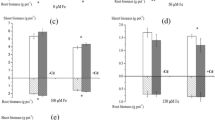Abstract
Sedum alfredii, a cadmium (Cd) and zinc (Zn) hyperaccumulator at a mine located in Qu Zhou City, Zhejiang Province, China, can accumulate Cd and Zn exceeding 1,000 and 10,000 mg kg−1, respectively in its shoot (dry weight) when growing under metal-contaminated habitats. Several strains of bacteria were isolated from the rhizosphere of S. alfredii thriving in different Pb/Zn mines in Hunan Province and Zhejiang Province, China, which can resist high levels of heavy metals. Among the different strains isolated, Burkholderia cepacia showed the highest ability in mobilizing Cd and Zn as well as resisting high concentrations of soluble Zn (500 mg L−1). The soluble Zn concentration in the medium increased from 13 to 72 and 99% (p < 0.001) after bacterial inoculation in the medium supplemented with insoluble zinc oxide and zinc carbonate, respectively, while pH dropped from 7 to 2.93. The soluble Cd concentration was also increased from 8 to 96% (p < 0.001), and pH decreased from 7 to 2.65. Short-chain organic acids were also analyzed and the results indicated that oxalic acid, tartaric acid, formic acid and acetic acid had a significant correlation (p < 0.001) with the concentrations of Cd and Zn being mobilized during the assay. The present results implicated that certain bacteria associated with metal hyperaccumulators could contribute significantly in mobilizing heavy metals, which would enhance the phytoextraction process.





Similar content being viewed by others
References
Baker AJM, Brooks RR (1989) Terrestrial higher plants which hyperaccumulate metallic elements—a review of their distribution, ecology and phytochemistry. Biorecovery 1:81–126
Baker AJM, McGrath SP, Sidoli CMD, Reeves RD (1994) The possibility of in situ heavy metal decontamination of polluted soils using crops of metal-accumulating plants. Resour Conserv Recycling 11:19–41. doi:10.1016/0921-3449(94) 90077-9
Blaylock MJ, Salt DE, Dushenkov S, Zakharova O, Gussman C, Kapulnik Y, Ensley BD, Raskin I (1997) Enhanced accumulation of Pb in Indian mustard by soil-applied chelating agents. Environ Sci Technol 31:860–865. doi:10.1021/es960552a
Brown SL, Chaney RL, Angle JS, Baker AJM (1994) Phytoremediation potential of Thlaspi caerulescens and bladder campion for zinc and cadmium-contaminated soil. J Environ Qual 56:1151–1157
Brun LA, Maillet J, Hinsinger P, Pepin M (2001) Evaluation of copper availability to plants in copper-contaminated vineyard soils. Environ Pollut 111:293–302. doi:10.1016/S0269-7491(00)00067-1
Byrnes ME (1994) Field Sampling Methods for Remedial Investigations. CRC, Boca Raton
Chaney RL (1983) Plant uptake of inorganic waste. In: Parr JE (ed) Land Treatment of Hazardous Waste. Noyes Data Corp, Park Ridge, NJ, pp 50–76
Chen YX, Wang YP, Lin Q, Luo YM (2005) Effect of copper-tolerant rhizosphere bacteria on mobility of copper in soil and copper accumulation by Elsholtzia splendens. Environ Int 31:861–866. doi:10.1016/j.envint.2005.05.044
Chiu KK, Ye ZH, Wong MH (2005) Enhanced uptake of As, Zn, and Cu by Vetiveria zizanioides and Zea mays using chelating agents. Chemosphere 60(10):1365–137. doi:10.1016/j.chemosphere.2005.02.035
Crowley DE, Wang YC, Reid CPP, Szansiszlo PJ (1991) Mechanism of iron acquisition from siderophores by microorganisms and plants. Plant Soil 130:179–198. doi:10.1007/BF00011873
De Souza MP, Chu D, Zhao M, Zayed AM, Ruzin SE, Schichnes D, Terry N (1999) Rhizosphere bacteria enhance selenium accumulation and volatilization by Indian mustard. Plant Physiol 119:565–573. doi:10.1104/pp. 119.2.565
Devevre O, Garbaye J, Botton B (1996) Release of complexing organic acids by rhizosphere fungi as a factor in Norway Spruce yellowing in acidic soils. Mycol Res 100:1367–1374. doi:10.1016/S0953-7562(96)80065-7
Di Simine CD, Sayer JA, Gadd GM (1998) Solubilization of zinc phosphate by a strain of Pseudomonas fluorescens isolated from forest soil. Biol Fertil Soils 28:87–4. doi:10.1007/s003740050467
Ernst WHO (1996) Bioavailability of heavy metals and decontamination of soils by plants. Appl Geochem 11:163–167. doi:10.1016/0883-2927(95)00040-2
Fasim F, Ahmed N, Parsons R, Gadd GM (2002) Solubilization of zinc salts by a bacterium isolated from the air environment of a tannery. FEMS Microbiol Lett 213:1–6. doi:10.1111/j.1574-6968.2002.tb11277.x
Fomina M, Alexander IJ, Hillier S, Gadd GM (2004) Zinc phosphate and pyromorphite solubilization by soil plant-symbiotic fungi. Geomicrobiol J 21:351–356. doi:10.1080/01490450490462066
Forstner U (1995) Land contamination by heavy metals: Global scope and magnitude of problem. In: Allen HE (ed) Metal speciation and contamination of soils. Lewis Publishers, Boca Raton
Franz A, Burgstaller W, Schinner F (1991) Leaching with Penicillium simplicissium: influence on metals and buffers on proton extrusion and citric acid production. Appl Environ Microbiol 57:769–4
Franz A, Burgstaller W, Muller B, Schinner F (1993) Influence of medium components and metabolic inhibitors on citric acid production by Penicillium simplicissimum. J Gen Microbiol 139:2101–2107
Gadd GM (1999) Fungal production of citric and oxalic acid: importance in metal speciation, physiology and biogeochemical processes. Adv Microb Physiol 41:47–92. doi:10.1016/S0065-2911(08)60165-4
Huang JW, Chen JJ, Berti WR, Cunningham SD (1997) Phytoremediation of lead-contaminated soils: role of synthetic chelates in lead phytoremediation. Environ Sci Technol 31:800–805. doi:10.1021/es9604828
Institute of Botany (1972) The Chinese academy of sciences, Eds. Iconographia cormophytorum sinicorum. Science: Beijing, China
Knight B, Zhao FJ, McGrath SP, Shen ZG (1997) Zinc and cadmium uptake by the hyperaccumulator Thlaspi caerulescens in contaminated soils and its effects on the concentration and chemical speciation of metals in soil solution. Plant Soil 197:71–78. doi:10.1023/A:1004255323909
Kos B, Lestan D (2003) Induced phytoextraction/Soil washing of lead using biodegradable chelate and permeable barriers. Environ Sci Technol 37(3):624–629. doi:10.1021/es0200793
Little TM, Hills JJ (1978) Agricultural Experimentation: Design and Analysis. Wiley, Chichester
Long XX, Yang XE, Ye ZQ, Ni WZ, Shi WY (2002) Differences of uptake and accumulation of zinc in four species of Sedum. Acta Bot Sin 44:152–157
Marin AR, Pezeshki SR, Masscheleyn PH, Choi HS (1993) Effect of dimethylarsenic acid (DMAA) on growth, tissue arsenic, and photosynthesis of rice plants. J Plant Nutr 16:865–880. doi:10.1080/01904169309364580
Martino E, Perotto S, Parsons R, Gadd GM (2003) Solubilization of insoluble inorganic zinc compounds by ericoid mycorrhizal fungi derived from heavy metal polluted sites. Soil Biol Biochem 35:133–141. doi:10.1016/S0038-0717(02)00247-X
Meers E, Ruttens A, Hopgood MJ, Samson D, Tack FMG (2005) Comparison of EDTA and EDDS as potential soil amendments for enhances phytoextraction of heavy metals. Chemosphere 58:1011–1022. doi:10.1016/j.chemosphere.2004.09.047
Ministry of Housing Netherlands (1994) Dutch intervention values of heavy metals and organic pollutants in soils, sediments, and ground water. Physical Planning and Environmental Conservation Report HSE 94.021
Nascimento CWA, Amarasiriwardena D, Xing B (2006) Comparison of natural organic acids and synthetic chelates at enhancing phytoextraction of metals from a multi-metal contaminated soil. Environ Pollut 140:114–123. doi:10.1016/j.envpol.2005.06.017
Nautiyal CS, Bhadauria S, Kumar P, Lal H, Mondal R, Verma D (2000) Stress induced phosphate solubilization in bacteria isolated from alkaline soils. FEMS Microbiol Lett 182:291–296. doi:10.1111/j.1574-6968.2000.tb08910.x
Page AL, Miller RH, Keeney DR (1982) Methods of Soil Analysis. Part 2 – Chemical and Microbiological Properties, 2nd edn. Agronomy, no.9, ASA, SSSA Publishing, Madison, p 1159
Salt DE, Blaylock M, Kumar NP, Dushenkov V, Ensley BD, Chet I, Raskin I (1995) Phytoremediation: a novel strategy for the removal of toxic metals from the environment using plants. Biotechnol 13:468–475. doi:10.1038/nbt0595-468
Sayer JA, Raggett SL, Gadd GM (1995) Solubilization of insoluble metal compounds by soil fungi: development of a screening method for solubilizing ability and metal tolerance. Mycol Res 99:987–993. doi:10.1016/S0953-7562(09)80762-4
Schwartz C, Echevarria G, Morel JL (2003) Phytoextraction of cadmium with Thlaspi caerulescens. Plant Soil 249:27–35. doi:10.1023/A:1022584220411
US Environmental Protection Agency (2001) Method 3052: Microwave assisted acid digestion of siliceous and organically based matrices. U.S. Environmental Protection Agency, Washington, DC
Wang A, Angle J, Chaney R, Delorme T, Reeves R (2006) Soil pH Effects on Uptake of Cd and Zn by Thlaspi caerulescens. Plant Soil 281:325–337. doi:10.1007/s11104-005-4642-9
Whiting SN, de Souza MP, Terry N (2001) Rhizosphere bacteria mobilize Zn for hyperaccumulation by Thlaspi caerulescens. Environ Sci Technol 35:3144–3150. doi:10.1021/es001938v
Wu LH, Luo YM, Zing XR, Christie P (2004) EDTA-enhanced phytoremediation of heavy metal contaminated soil with Indian mustard and associated potential leaching risk. Agric Ecosyst Environ 102:307–318. doi:10.1016/j.agee.2003.09.002
Wu SC, Cheung KC, Luo YM, Wong MH (2006) Effects of inoculation of plant growth promoting rhizobacteria on metal uptake by Brassica juncea. Environ Pollut 140:124–135. doi:10.1016/j.envpol.2005.06.023
Ye HB, Yang XE, He B, Long XX, Shi WY (2003) Growth response and metal accumulation of Sedum alfredii to Cd/Zn complex-polluted ion levels. Acta Bot Sin 9:1030–1036
Acknowledgments
The authors would like to thank Prof. Norman Terry (University of California, Berkeley) for the provision of bacterial strains, Prof. P.Y. Qian (Hong Kong University of Science & Technology) for the bacteria identification and Ms. Ursula Absalom for improving the manuscript. Financial support from the Research Grants Council of the University Grants Committee of Hong Kong and Area of Excellence (CityU/AoE/03-04/02) are gratefully acknowledged.
Author information
Authors and Affiliations
Corresponding author
Additional information
Responsible Editor: Petra Marschner.
Rights and permissions
About this article
Cite this article
Li, W.C., Ye, Z.H. & Wong, M.H. Metal mobilization and production of short-chain organic acids by rhizosphere bacteria associated with a Cd/Zn hyperaccumulating plant, Sedum alfredii . Plant Soil 326, 453–467 (2010). https://doi.org/10.1007/s11104-009-0025-y
Received:
Accepted:
Published:
Issue Date:
DOI: https://doi.org/10.1007/s11104-009-0025-y




